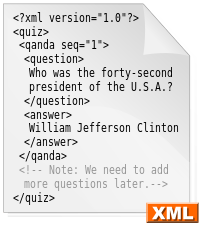SQL/XML
SQL/XML or XML-Related Specifications is part 14 of the Structured Query Language (SQL) specification. In addition to the traditional predefined SQL data types like NUMERIC, CHAR, TIMESTAMP, ... it introduces the predefined data type XML together with constructors, several routines, functions, and XML-to-SQL data type mappings to support manipulation and storage of XML in a SQL database.
Specification
The specification defines the data type XML, functions for working with XML, including element construction, mapping data from relational tables, combining XML fragments, and embedding XQuery expressions in SQL statements. Functions which can be embedded include XMLQUERY (which extracts XML or values from an XML field) and XMLEXISTS (which predicates whether an XQuery expression is matched).
Further information and examples of the SQL/XML functions are provided in the external links below.

XML
Extensible Markup Language (XML) is a markup language that defines a set of rules for encoding documents in a format which is both human-readable and machine-readable. It is defined by the W3C's XML 1.0 Specification and by several other related specifications, all of which are free open standards.
The design goals of XML emphasize simplicity, generality and usability across the Internet. It is a textual data format with strong support via Unicode for different human languages. Although the design of XML focuses on documents, it is widely used for the representation of arbitrary data structures such as those used in web services.
Several schema systems exist to aid in the definition of XML-based languages, while many application programming interfaces (APIs) have been developed to aid the processing of XML data.
Applications of XML
As of 2009, hundreds of document formats using XML syntax have been developed, including RSS, Atom, SOAP, and XHTML. XML-based formats have become the default for many office-productivity tools, including Microsoft Office (Office Open XML), OpenOffice.org and LibreOffice (OpenDocument), and Apple's iWork. XML has also been employed as the base language for communication protocols, such as XMPP. Applications for the Microsoft .NET Framework use XML files for configuration. Apple has an implementation of a registry based on XML.

SQL
SQL (![]() i/ˈɛs kjuː ˈɛl/, or
i/ˈɛs kjuː ˈɛl/, or ![]() i/ˈsiːkwəl/;Structured Query Language) is a special-purpose programming language designed for managing data held in a relational database management system (RDBMS), or for stream processing in a relational data stream management system (RDSMS).
i/ˈsiːkwəl/;Structured Query Language) is a special-purpose programming language designed for managing data held in a relational database management system (RDBMS), or for stream processing in a relational data stream management system (RDSMS).
Originally based upon relational algebra and tuple relational calculus, SQL consists of a data definition language, data manipulation language, and a data control language. The scope of SQL includes data insert, query, update and delete, schema creation and modification, and data access control. Although SQL is often described as, and to a great extent is, a declarative language (4GL), it also includes procedural elements.
SQL was one of the first commercial languages for Edgar F. Codd's relational model, as described in his influential 1970 paper, "A Relational Model of Data for Large Shared Data Banks." Despite not entirely adhering to the relational model as described by Codd, it became the most widely used database language.
SQL 2008
SQL 2008 can refer to
SQL:2006
SQL:2006 or ISO/IEC 9075:2006 standard is the fifth revision of the ISO standard for the SQL database query language.
The main changes from SQL:2003 were in the Part 14 of the standard.
Part 14
ISO/IEC 9075-14:2006 defines ways in which SQL can be used in conjunction with XML. It defines ways of importing and storing XML data in an SQL database, manipulating it within the database and publishing both XML and conventional SQL-data in XML form. In addition, it enables applications to integrate into their SQL code the use of XQuery, the XML Query Language published by the World Wide Web Consortium (W3C), to concurrently access ordinary SQL-data and XML documents.
See also
Podcasts:

